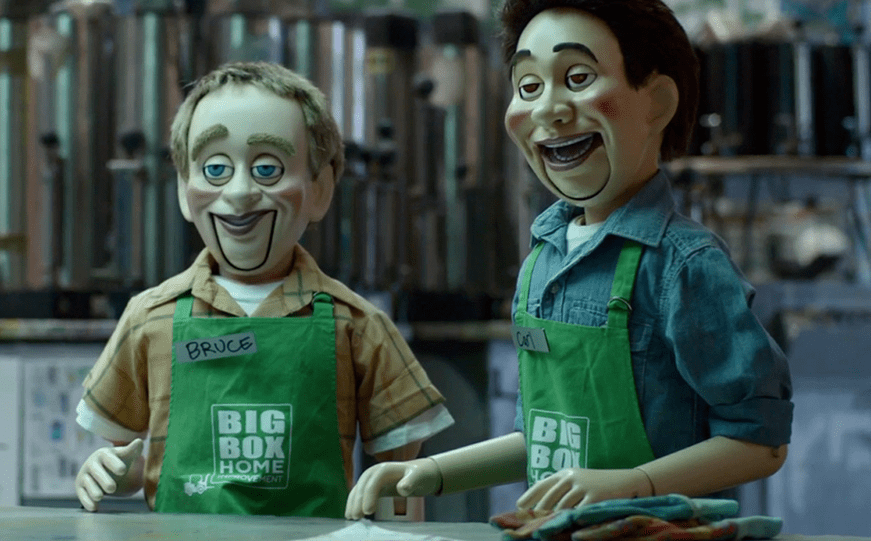In the latest phase of the largest ad campaign in the 132-year history of Benjamin Moore, the paint dealer brand hits a home run by asking the customer a simple question – “Who are you talking to?”
Part of an aggressive and robust $50 million national campaign, the Montvale, N.J.-based manufacturer of high-end residential, commercial and industrial maintenance paint and other architectural coatings, uses a bit of humor in a TV commercial, poking fun at the “big-box” chains that by design, do not sell Benjamin Moore products.
Having aired more than 1,200 times across the nation, in this commercial, a customer comes to the paint counter inside a store named Big Box Home and asks two employees about staining a deck.
Introducing Bruce and Carl
The two employees, Bruce and Carl, are puppets wearing green aprons, which is a subtle alternate color dig at the big box chains, The Home Depot and Lowe’s. These two Big Box Home puppets begin conversing among themselves and decide that the customer needs to speak to Jerry, aka Deck Stain Jerry. The only problem is… surprise: Jerry no longer works at Big Box Home. Care to ponder the strategic priority of this spot’s nod to the customer service and staff retention issues plaguing the two big box home improvement retailers today?
The second half of the commercial moves away from Bruce and Carl and Big Box Home to a Benjamin Moore store with a voice saying, “If you’re not talking to your Benjamin Moore retailer, who are you talking to? Because only an authorized Benjamin Moore retailer can give you expert advice.”
Despite some concern about potential “creepiness” of the puppets, the poignant commercial, which debuted this summer, positions the Benjamin Moore independent dealer sales associate as the expert in paint products.
Through humor, the commercial seizes upon the situation – that while big box home improvement stores can be a convenient one-stop shop for anything from painting products to appliances and tools – when the consumer is looking for advice, he or she is likely to be more challenged at those stores than when visiting an independent dealer.
What’s in the Box? Not Benjamin Moore
Part of its current campaign and the first major ad campaign under chief marketing officer Ron Schuller, the paint company has two other commercials featuring Bruce and Carl. The theme for each of the 30-second spots revolves around customers asking for assistance with various home painting projects and receiving all sorts of pointless advice from two clueless puppets… arguably who are employed by any one of the major big box chains.
Unlike its competitors, including Valspar, Behr and PPG (which owns Glidden)… who all rely on big box chains like The Home Depot and Lowe’s to retail their paint products, Benjamin Moore is providing the consumer with much more than a high-quality architectural covering. Benjamin Moore is also offering valuable customer service for the do-it-yourselfer.
Perfect Time to Increase Marketing
As we are painfully still aware, when the Great Recession hit the construction channel in 2009, the housing market suffered a major hit – which, in turn, severely damaged the architectural coatings industry. Painting companies, which had sold close to 800 million gallons of paint in 2008, saw that total decline by nearly 200 million gallons.
While some of the smaller paint companies closed their doors, the major paint brands began acquiring smaller companies to help weather the storm. In fact, the nation’s leading paint company, Sherwin-Williams, purchased the number one paint company in Mexico.
PPG increased its distribution by purchasing Akzo Nobel’s North American Architectural Coating business, which produces brands such as CIL, Glidden and Dulux. Not to be outdone, Valspar also threw its hat into the ring. Attempting to stay competitive in the paint market with the big boys, the Minneapolis-based company entered into an agreement with Ace Hardware. Valspar manufactures Ace-branded paint products and produces a comprehensive line of Valspar-branded paints aimed at more than 4,000 Ace Hardware retail stores around the nation.
As a result of these agreements, Sherwin-Williams, PPG and Valspar account for 70 percent of architectural coating market in North America. That leaves Benjamin Moore battling several other paint companies, including Behr, for an important share of the market.
Although the coatings industry has not returned to the same production level as pre-recession, there has been a steady improvement.
“The brand [Benjamin Moore] has been increasing spending since the economy began picking up again,” Schuller says. “North American and global sales are increasing for Benjamin Moore. The overall market for paint is better than a year ago as well.”
Shifting Strategies by Marketing Smarter
Yes, Benjamin Moore has struggled to keep up with the big boys. While its revenues rose 40 percent from 1999 to 2013, Sherwin-Williams and Valspar saw their revenue increase 104 % and 196 % respectively, according to Fortune.
Focused on closing the gap, Benjamin Moore has increased its marketing budget each year since 2012 to aid in building the Benjamin Moore brand on a national scale. The company increased its ad spend by 92% in 2013 alone. Benjamin Moore has traditionally spread its marketing investment among magazine, cable TV and online advertising… but this year’s “Who Are You Talking To?” national campaign is a deviation from the norm.
The messaging and targeting is clearly different. In a 2013 campaign, called “Main Street Matters,” Benjamin Moore crafted a campaign directed at the professional painter and contractors.
Benjamin Moore has rethought its strategy and is now trying to connect with the growing DIY-market – and Bruce and Carl are helping – thanks to their witty buffoonery. Will the new DIY “pull” strategy ultimately trump the “repeat-influencer” campaign of yesteryear? We’ll keep you posted on this brand and the entire channel – which is expected to grow to some $30 billion by 2021.





